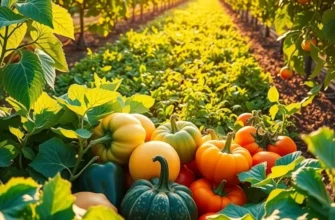Sustainable eating is about making food choices that prioritize the well-being of our planet while nourishing our bodies. As food production and consumption impact climate change and ecosystems, adopting sustainable practices can contribute to a healthier Earth. This guide aims to provide simple, actionable steps that anyone can take to start their sustainable eating journey, making eco-friendly choices accessible to all.
Understanding Sustainable Eating

Sustainable eating is more than a dietary choice; it is a mindful act of nurturing our planet. At its core, sustainable eating emphasizes consuming foods that safeguard the environment, support local economies, and contribute to a balanced ecosystem. This method of eating considers the entire lifecycle of food products—from farming and processing to packaging and transportation—ensuring that each stage is ecologically viable.
One of the greatest environmental benefits of sustainable eating is the reduction of carbon footprint. Agriculture is a significant contributor to greenhouse gas emissions. By making conscious food choices, we can help reduce these emissions. For instance, opting for locally-sourced produce minimizes transportation-related emissions. Furthermore, sustainable practices often involve reduced pesticide and fertilizer use, which keeps soil and water systems healthier.
Key principles of sustainable eating include seasonal eating, plant-based diets, and mindful consumption.
Seasonal Eating: This involves consuming fruits and vegetables that are currently in season. Seasonal produce requires fewer resources for growth, as it thrives in its natural environment. This not only reduces the environmental cost but also offers fresher, more nutritious food options. Supporting local farms can be a fun seasonal activity and ensures that your diet aligns with nature’s rhythms.
Plant-Based Diets: Reducing meat and dairy consumption in favor of plant-based foods has a profound environmental impact. Plant-based diets generally use fewer resources and produce less waste. They also contribute to biodiversity, as diverse cropping systems help maintain healthy ecosystems. For those interested in exploring this area further, our easy plant-based eating guide offers practical tips on incorporating more plants into your meals.
Mindful Consumption: This principle revolves around being aware of the lifecycle and impacts of the food we choose. Making informed choices about what and how much we eat can reduce food waste and overconsumption. Consider starting small, such as planning meals around leftovers or composting food scraps, which helps decrease overall waste.
Simple changes can create a meaningful and lasting impact. For example, switching to a reusable shopping bag and buying in bulk can reduce packaging waste. Trying a vegetarian meal once a week supports lower meat production demands, conserving water and energy. Engaging in community-supported agriculture (CSA) can foster local farms and reduce dependency on imported goods.
Every decision we make about food is a step towards a healthier lifestyle and a more sustainable planet. Although individual efforts might seem small, collectively, they can drive significant change. As we educate ourselves and adapt, our choices reflect our commitment not only to our health but the broader ecosystem. Sustainable eating invites us to be part of the solution, nurturing both ourselves and the planet.
Practical Steps to Sustainable Eating

Taking small but impactful steps towards sustainable eating can significantly benefit both the environment and your health. One of the most effective ways to start is by selecting local and seasonal produce. Locally sourced foods often require less transportation, decreasing their carbon footprint. Moreover, seasonal produce tends to be fresher and more flavorful. Visit farmers’ markets to connect with local growers and discover what’s in season.
Minimizing food waste is an integral part of sustainable eating. Begin by planning meals and only purchasing what you need. Use leftovers creatively; for instance, transform last night’s roasted vegetables into a hearty soup for today. Embrace the concept of ‘root-to-stem’ cooking, where you utilize every part of the vegetable. If you’re looking for more ideas, our low-waste cooking guide offers further tips.
Choosing plant-based meals is another practical step. You don’t need to fully commit to a vegetarian or vegan lifestyle to make a difference. Start by incorporating a few plant-based meals each week. Beans, lentils, and tofu are excellent sources of protein and offer diverse culinary possibilities.
When shopping, reading labels carefully can inform more eco-conscious decisions. Look for certifications indicating sustainable practices, such as organic or fair trade. Beyond certifications, pay attention to ingredient lists and try to choose products with minimal processing and additives.
Turning your kitchen into a hub for sustainability also involves meal planning and preparation. A thought-out plan can prevent impulsive purchases and reduce waste significantly. Consider batching ingredients to streamline your cooking process and ensure you use what you have. You can find useful strategies in our practical ingredient batching guide.
Composting is another valuable addition to your kitchen routine. Composting food scraps not only reduces waste but also creates nutrient-rich soil for your garden or potted plants. It’s a simple yet effective way to close the loop in your food system.
Finally, consider adopting eco-friendly cooking methods. Using energy-efficient appliances and cooking techniques can save both energy and time. For example, simmering meals with lids on reduces cooking time and retains heat. Explore alternatives like steaming, grilling, or raw food preparations to diversify your meals.
By taking these actionable steps, sustainable eating becomes an achievable part of your daily routine. You’ll not only help the planet but also discover a richer and more varied palette of flavors within your meals.
Final words
Embarking on a sustainable eating journey can significantly contribute to environmental conservation and personal wellness. By understanding the principles of sustainable eating and implementing practical steps, you can make a difference without compromising on taste or enjoyment. Start with small changes, such as incorporating more plant-based meals or buying local produce. Every positive choice you make sends a ripple effect into the world, encouraging others to follow suit. Remember, it’s about progress over perfection—each step counts in nurturing both your health and the planet.








